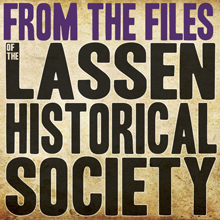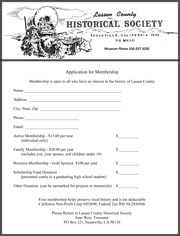

Did you miss Part One of our story?
Click here to read last week’s edition.
by Susan Couso
Local judge, Ben Curler, recused himself from the case, and Judge C. A. Paulson was brought in from Weaverville to preside. Curler, while serving as Lassen County District Attorney, had already heard much about the case from both sides.
Then, on the 17th, Paulson postponed the proceedings as Frances Dundas, a major witness to the case, was ill with pneumonia at her home in Upland.
On March 16th, 1937, the hearing began, in a courtroom completely packed with those ready to be entertained with juicy stories of sex and corruption.
First to testify was George Odette, who had been the complainant who sent the case to the courts. Questioned by the attorney for the prosecution, Hardin Barry, he testified for several hours, detailing the events involving Funderburgh and his improper conduct.
Odette testified that on several occasions he had seen Funderburgh and Frances Dundas in the darkened building. Once, he said they were “loving and kissing.”
Cross examination from Funderburgh’s counsel, Anthony Kennedy, from Sacramento, took several more hours, but brought no new enlightenment to Odette’s story.

Next up was janitor Albert Chittock, who basically supported Odette’s recollections and added some of his own, all damning to Funderburgh.
Then, Robert M. Fulton and Maynard Buckles testified that they had been secretly watching Funderburgh and Dundas, and had found them working together and caressing each other.
The testimonies continued with Minnie Roseberry retelling her experiences with Funderburgh and several others, some in defense of Funderburgh’s character, telling their side of things.
Optometrist, L. A. Olmstead testified as to whether someone could actually read a license plate under a street light at 50 feet, as was claimed.
Funderburgh took the stand and defended himself, charging that the whole thing was caused by a bunch of disgruntled teachers who were antagonistic and uncooperative.
Throughout it all, no one changed their testimony or their mind. It was a conflict without end. But a decision from Judge Paulson came down on March 20,1937, freeing Funderburgh of all charges. Paulson’s judgment was a well-written statement detailing the animosity and petty actions of a group of angry people.
The Nevada State Journal reported:
In the decision, Paulson declared that “it should be observed at the outset that the charges made, if all were true, do not include acts which are commonly considered as ‘gross’ immorality. The welfare of our schools demands that a high standard be maintained by our teachers, but the law has not declared that every trivial act or even every improper act may be made a ground of dismissal.”
Paulson also remarked that the evidence produced in support of the allegations came from “strongly biased witnesses,” and that it was apparent during the trial of the case that “the witnesses and parties alike had become involved in a bitter faction fight.”
The verdict was given to Lassen County Clerk Maud Toombs on March 22nd.
One would assume that things calmed down a bit at the high school, but one would be incorrect.
The Board of Trustees, in an attempt to ‘clean house’ and make themselves look a bit less foolish, met on April 5th to consider sweeping changes. They voted not to renew the contract with Funderburgh, and they also voted to reprimand those who had made accusations against him.
The board voted to let George Odette’s contract expire, but because Albert Chittock had worked at the school for 20 years, they decided that he could stay.
Then they adopted a resolution stating that unless four of the teachers who had brought charges against Funderburgh resigned, they would bring charges of “unprofessionalism” against them.
They also decided not to reemploy Minnie Roseberry.
The four ‘tenured’ teachers named in the action were Med Arnold, Maynard Buckles, Robert Fulton and Mary Hardy. They also moved to remove E. A. Hansen and A. J. Berg, but then withdrew Berg’s name.
Funderburgh addressed the board and said that a failure of the board to renew his contract would place an undue hardship upon his family.
The Lassen County Superior Court, while handing down its decision to vindicate Funderburgh, had instructed the Lassen Board of Trustees to pay Funderburgh’s legal fees.
They also were ordered by the court to dismiss the complaint against George Odette and forbade them from dismissing the principal or the teachers.
The five tenured teachers were protected by the California Tenure of Office Act and could not be reprimanded or fired without the sanction of the State Board of Education. The board sent papers to the state board for review and consideration, and the state board labeled the Lassen situation “a dirty mess.”
The state board also determined that the Lassen County Board of Education had jurisdiction over the case. The Lassen County Board of Education apparently wanted to stay as far away as possible from the high school debacle.
All five of the teachers refused to resign saying, “We do not intend to resign, because this would be an admission of guilt, and we all stand firmly together when we say we are innocent.” They enlisted Hardin Barry to defend their actions.
The actions of the board of trustees did not quell the volatile conditions at the school. It was more like flipping a lit match into a pool of gasoline.
Funderburgh acted as he had done repeatedly in the past, and submitted his resignation. He made it very clear that he was not a candidate for reinstatement. He cited various reason as to why he would not return making statements against the board members and the faculty. Apparently, he did not understand that he had not been asked to come back.
Then, Arthur Mathews, a supporter of Funderburgh from the start, asked to have him reinstated, and there were a few other supporters that thought that Funderburgh had received a ‘raw deal.’
Funderburgh was well-like by the student body at Lassen Union High School. Now, with the news of his ‘dismissal’ by the board, the student population sprang into action.

Led by Mario Vial, senior and student body president, students walked out of classes on May 4th and circulated a petition supporting Funderburgh. The petition, asking that the board retain Funderburgh, contained 291 signatures of students who wanted Funderburgh in and the teachers out. The paperwork was read by Vial and submitted to the Board of Trustees who politely listened but accepted Funderburgh’s resignation anyway, pointing out that the students really had no ‘say’ in the matter.
On May sixth, about 400 of the 433 students who attended the school held an all-day meeting in the gymnasium to consider their options, which were few. They even discussed declaring a ‘strike’. Funderburgh had given permission for this student protest, which stopped all classes.
By the time junior college students showed up, the crowd had swelled to about 450 people. Vial, in charge of the proceedings, called the meeting to order using a regular claw hammer for a gavel.
Interested parents began to arrive and some called the gathering ‘outrageous’, claiming the rally was fueled by students who were “known to be more interested in disturbances than studies.”
They supported the teachers and demanded that the students return to class.
It was a raucous affair. At one point, Elsie Lee Thorburn, mother of a junior college student, placed herself next to Vial in the gym and announced that the gathering was a “disgrace”. She demanded that they adjourn immediately, and then took a folding chair and hammered it on the floor, making sure to garner adequate attention. Vial and others attempted to subdue her, but were unsuccessful.
At the end of three hours of hot tempers and loud outbursts, Funderburgh seemed to understand that his cause was lost, and he ended the rally by telling the students to return to class. They did as he requested and filed out of the gymnasium.
By May 7th, it was over. Students were back in class, and though grievances remained strongly embedded in most participants, cooler heads prevailed.
On June 9th, unable to get rid of those pesky teachers who had caused so much turmoil, the board of trustees voted to increase the wages of all teachers except five: Med Arnold, Robert Fulton, Maynard Buckles, Mary Hardy and E. A. Hansen.
Norman H. McCollum, formerly principal at McArthur High School was chosen to replace Funderburgh. He was instructed to hire three new instructors to replace Minnie Roseberry, Florence Scott, and A. J. Berg.
Isaac Funderburgh moved on again. This time to Alameda County, where he was hired as principal of Albany High School. But by 1940, he was in Santa Barbara working as director of the State Relief Administration.
By 1943, Funderburgh became the pastor of the Church of the Brethren in Pasadena, where he remained until his retirement. He died in San Jose in 1971.

If you are a fan of our weekly history stories you should join the Lassen County Historical Society! It’s a fun way to be a part of our county’s rich history. When you sign up, you’ll receive regular Historical Society newsletters with interesting stories and information. Membership is open to anyone with an interest in area history.
Through your membership you help preserve local history. You can download a membership application by clicking here.





